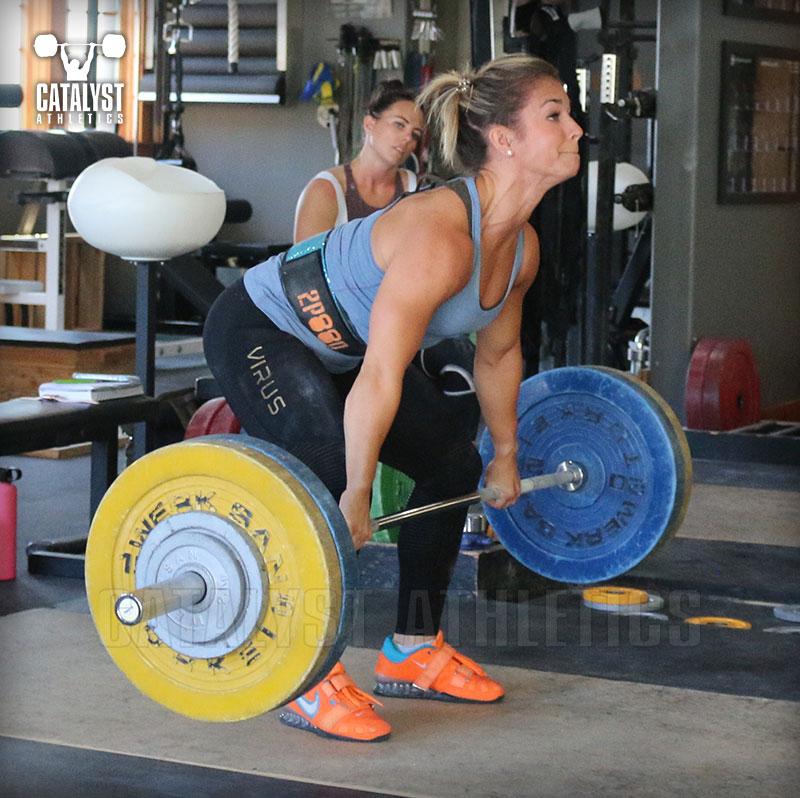Ask Greg: Issue 202

Zac Asks: What are the differences between having a narrower foot position at the start of a snatch versus wider? I’ve heard people say before that having too wide of start position doesn’t allow them to get low enough in a squat but also too narrow of a stance causes the feet to have to cover some ground when receiving the bar. Are there benefits/cons to both?
Greg Says: The pulling stance for the snatch and clean is going to vary among lifters and even between the two lifts for a given athlete in many cases. They should be determined based on what works best for the athlete—and keeping in mind, despite what the people you’ve talked to are implying—that the pulling stance doesn’t directly affect the receiving stance.
At the most textbook-level, we want a pulling stance that orients the legs vertically when standing, i.e. positions the heels directly under the hips, and with the toes turned out about 10-20 degrees from the centerline. This ensures the force the legs are producing is pushing directly into the ground and therefore directly back up into the bar rather than some of that force being lost through vectors (moving diagonally from the direction we want).
However, there are more elements to the pulling stance we have to consider—how does the stance influence our starting position and first pull, for example. Our proportions and/or mobility may dictate a different stance to allow us to set the proper position and move well through the navigation past the knees and maintain balance.
The receiving stance is totally independent of the pulling stance because it involves different positions and movements—a deep squat rather than a pull. This again needs to be determined individually to create the ideal squat position for each lifter.
If you execute the lift well, moving your feet from a particularly narrow pulling stance to a particularly wide receiving stance isn’t a problem. If you’re unable to move your feet that much, the stances aren’t the problem—the problem is related to the force, balance or timing at the top of the pull.
In short, figure out your ideal pulling and receiving stances, and then address any problems transitioning between the two directly.
Greg Says: The pulling stance for the snatch and clean is going to vary among lifters and even between the two lifts for a given athlete in many cases. They should be determined based on what works best for the athlete—and keeping in mind, despite what the people you’ve talked to are implying—that the pulling stance doesn’t directly affect the receiving stance.
At the most textbook-level, we want a pulling stance that orients the legs vertically when standing, i.e. positions the heels directly under the hips, and with the toes turned out about 10-20 degrees from the centerline. This ensures the force the legs are producing is pushing directly into the ground and therefore directly back up into the bar rather than some of that force being lost through vectors (moving diagonally from the direction we want).
However, there are more elements to the pulling stance we have to consider—how does the stance influence our starting position and first pull, for example. Our proportions and/or mobility may dictate a different stance to allow us to set the proper position and move well through the navigation past the knees and maintain balance.
The receiving stance is totally independent of the pulling stance because it involves different positions and movements—a deep squat rather than a pull. This again needs to be determined individually to create the ideal squat position for each lifter.
If you execute the lift well, moving your feet from a particularly narrow pulling stance to a particularly wide receiving stance isn’t a problem. If you’re unable to move your feet that much, the stances aren’t the problem—the problem is related to the force, balance or timing at the top of the pull.
In short, figure out your ideal pulling and receiving stances, and then address any problems transitioning between the two directly.
| Greg Everett is the owner of Catalyst Athletics, publisher of The Performance Menu Journal and author of Olympic Weightlifting: A Complete Guide for Athletes & Coaches, Olympic Weightlifting for Sports, and The Portable Greg Everett, and is the writer, director, producer, editor, etc of the independent documentary American Weightlifting. Follow him on Facebook here. |
Search Articles
Article Categories
Sort by Author
Sort by Issue & Date
Article Categories
Sort by Author
Sort by Issue & Date

